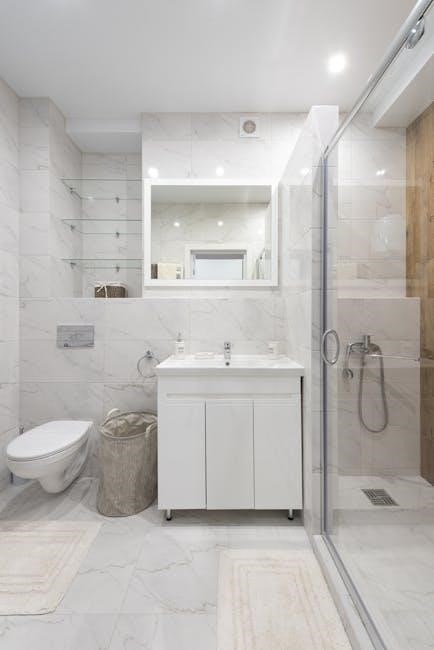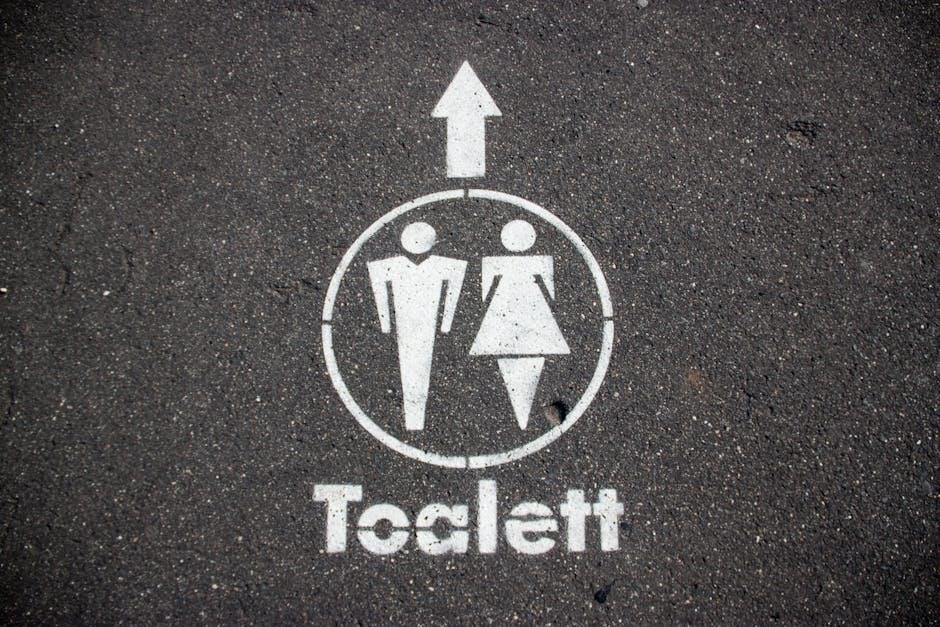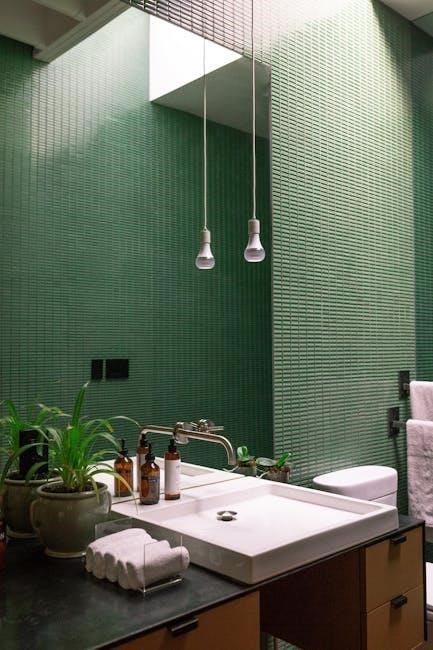A zero-gravity toilet uses airflow to manage waste in weightless environments. Designed for space missions, it ensures hygiene and safety, adapting to microgravity conditions while resembling Earth-based toilets.

Overview of Zero Gravity Toilet Technology
Zero-gravity toilets rely on advanced engineering to function in weightless environments. They use airflow to direct and collect waste, eliminating the need for gravity. These systems are designed to maintain hygiene and efficiency in space missions. NASA has developed toilets with Teflon-coated chambers for self-cleaning and airflow mechanisms to manage waste. They feature handholds and footholds for stability. The toilets are compact, lightweight, and integrate with water recycling systems. This technology is crucial for long-duration missions, ensuring waste is stored safely and resources are conserved. The design prioritizes astronaut comfort and ease of use, addressing feedback for improved functionality. These innovations highlight the challenges and solutions in space sanitation, making zero-gravity toilets essential for future space exploration.

Historical Context and Development
The concept of zero-gravity toilets emerged during the early years of space exploration. In the 1960s, astronauts relied on simple collection bags, which were cumbersome and often led to discomfort. The first significant advancements came in the 1980s with NASA’s Space Shuttle program, introducing toilets that utilized airflow to manage waste. These systems were rudimentary but marked the beginning of zero-gravity sanitation. The International Space Station (ISS) brought further innovations, with toilets featuring Teflon-coated chambers and improved waste management. Over time, NASA refined the designs, addressing challenges like liquid and solid waste separation. The development process involved extensive research and astronaut feedback, leading to more hygienic and user-friendly systems. This evolution underscores the critical role of zero-gravity toilets in sustaining long-duration space missions and advancing space exploration. Their design reflects decades of problem-solving and technological adaptation.
Design and Functionality of Zero Gravity Toilets
Zero-gravity toilets use airflow to direct waste, feature Teflon-coated chambers for hygiene, and are designed for microgravity environments, resembling Earth toilets but with essential modifications.
Key Components and Mechanisms
The zero-gravity toilet relies on airflow systems to direct and collect waste, as gravity cannot pull waste downward. Key components include a Teflon-coated chamber for self-cleaning, a vacuum mechanism to ensure waste containment, and straps or pivoting bars to secure users. The toilet uses airflow instead of water, with waste separated into solids and liquids. Solids are compressed and stored, while liquids are vented or recycled. A urine hose and seat allow simultaneous use, and a separate receptacle handles wipes. The system is designed for low maintenance and efficiency, crucial for long-term space missions. These mechanisms ensure functionality in microgravity, maintaining hygiene and safety for astronauts.
Role of Airflow in Waste Management
Airflow is central to managing waste in zero-gravity toilets. Without gravity, air streams direct urine and feces into collection chambers. A vacuum-powered system ensures waste is captured and contained, preventing floating debris. The airflow also aids in separating liquids from solids, facilitating recycling of water for future use. This method eliminates the need for water, conserving resources in space. Filters within the system remove odors and bacteria, maintaining a clean environment. Airflow technology is essential for maintaining hygiene and efficiency in space-based sanitation, ensuring waste is managed effectively without relying on Earth-like gravity.

Step-by-Step Instructions for Using a Zero Gravity Toilet
Secure yourself with straps, position correctly, and use airflow to direct waste. Follow all safety guidelines to ensure proper function and hygiene in microgravity conditions.

Preparation and Safety Precautions
Before using a zero-gravity toilet, astronauts must secure themselves with straps to prevent floating away. Ensure the toilet system is functioning correctly, with proper airflow and a secure seal. The WCS (Waste Collection System) curtain should be closed to maintain privacy and prevent waste from escaping. Always follow the detailed instructions provided, as improper use can lead to contamination or system malfunctions. Hygiene is critical; use disposable wipes and ensure all waste is fully contained. Avoid distractions, as the unique conditions require careful attention. Proper preparation and adherence to safety protocols are essential for effective and sanitary use of the zero-gravity toilet in space environments.

Operating the Toilet: A Detailed Guide
Using a zero-gravity toilet involves a structured process. Astronauts begin by securing themselves with leg straps and thigh bars to remain stable. For urination, a specially designed hose is used, which can be attached to the commode or used while standing. The airflow system directs waste into the collection chamber. For bowel movements, the astronaut sits directly over the toilet seat, ensuring the waste is captured by the airflow. After use, disposable wipes are deposited into a separate receptacle. The system relies on air flow instead of water to manage waste, ensuring efficiency and hygiene. Proper alignment and adherence to the sequence are crucial for effective operation and to prevent contamination in the microgravity environment.

Challenges and Innovations in Zero Gravity Sanitation
Designing efficient zero-gravity toilet systems requires overcoming waste containment and hygiene challenges. Innovations like airflow technology and compact designs have improved functionality, addressing astronaut feedback for better comfort and usability.
Addressing Astronaut Feedback for Improved Comfort

NASA has prioritized astronaut feedback to enhance the comfort and usability of zero-gravity toilets. Designs now incorporate a smaller and lighter build, improving accessibility and reducing bulk. Astronauts emphasized the need for better integration with the space station’s water systems, enabling more efficient urine recycling. The toilets feature airflow technology to direct waste, eliminating the need for water. Straps and pivoting bars ensure stability, while a tight seal is crucial for proper function. These innovations aim to make long-duration missions more comfortable and hygienic, reflecting the importance of addressing user experiences in space sanitation. Continuous improvements are driven by astronaut insights, ensuring the system meets the unique challenges of microgravity environments.
Future Developments in Space Toilet Technology
Future advancements in zero-gravity toilet technology aim to enhance sustainability and efficiency for deep-space missions. Researchers are exploring systems capable of recycling wastewater into drinkable resources, reducing reliance on external supplies. Innovations may include compact, modular designs to save space and energy. Integration with hydroponic systems could utilize waste for growing food, creating closed-loop life support. Additionally, advanced airflow mechanisms and self-cleaning coatings like Teflon are being refined to minimize maintenance. These developments are crucial for long-term missions to the Moon, Mars, and beyond, ensuring reliable sanitation solutions in extreme environments. Collaboration between NASA and universities continues to drive these cutting-edge improvements, addressing both practical and environmental challenges.
Zero-gravity toilets symbolize human ingenuity in space exploration, while their depiction in popular culture, like in 2001: A Space Odyssey, highlights their unique fascination.

The Zero Gravity Toilet in Popular Culture
Zero-gravity toilets have captivated popular culture, often becoming a symbol of futuristic intrigue. Their unique design and functionality have been humorously and intriguingly portrayed in films like 2001: A Space Odyssey, where detailed instructions for using a zero-gravity toilet were a subtle joke. Similarly, The Martian highlighted their practical importance in space survival. TV shows like The Office and Star Trek have also referenced them, blending humor with science fiction. These portrayals reflect society’s fascination with space exploration and the challenges of everyday life in zero gravity. The toilets’ cultural significance lies in their ability to spark curiosity and amusement, bridging the gap between advanced technology and relatable human experiences.

Significance of Zero Gravity Toilets in Space Exploration
Zero-gravity toilets play a crucial role in space exploration by addressing the fundamental need for hygiene and waste management in microgravity environments; Their innovative design ensures the health and comfort of astronauts during long-duration missions. The use of airflow to direct waste and the integration of recycling systems for water and urine underscore their importance in sustaining life in space. These toilets are not just functional but also symbolize human ingenuity in overcoming the challenges of space travel. Their development has paved the way for more sustainable and efficient systems, essential for future missions to the Moon, Mars, and beyond.

